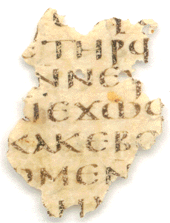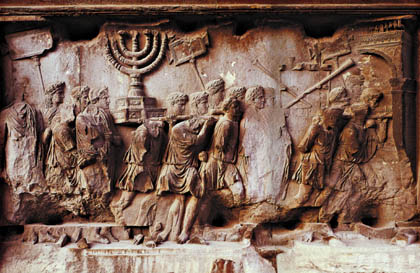Primitive Christianity
The first century or so of Christianity is sometimes called the "primitive" period.
The terms "apostolic period" and "subapostolic period" are sometimes used, although they aren't very exact. "Apostolic period" refers to Christianity in the lifetime of the first apostles. Some writers end the apostolic period in the CE 60s, on the premise that most of the apostles, including Peter and Paul, died then. Others end it at about CE 100, since the apostle John is thought to have survived until then. "Subapostolic period" refers to the following generation or so, which could be anywhere (roughly) from CE 60 to 110, or from CE 100 to 150. In the past the term "patristic period," meaning the period of the Church Fathers — the early theologians, bishops, and other influential writers — has often been used for the time after the subapostolic period, extending to CE 600 or later. The term is less useful now since (a) it can suggest that women didn't count and (b) it can suggest that ordinary Christians who weren't important writers didn't count.
Sources for the primitive Christianity
 The main historical source for primitive Christianity is the New Testament. (Pictured: papyrus fragment of Acts 21:25 in Coptic.) As a matter of scholarly convention, Church historians haven't usually specialized in primitive Christianity; they leave that to the New Testament scholars. Accordingly, this course won't linger on this period. That said, over the past generation or so, many scholars have combined New Testament studies with studies in early Christianity under the name "the study of Christian origins." Doing so gives better context and integration to both New Testament studies and early Church history studies. In particular, since we have no copies of any books of the New Testament from the first century, our reconstructions of the New Testament from various manuscript sources and quotations by later authors require us to take account of the Church in the second and later centuries.
The main historical source for primitive Christianity is the New Testament. (Pictured: papyrus fragment of Acts 21:25 in Coptic.) As a matter of scholarly convention, Church historians haven't usually specialized in primitive Christianity; they leave that to the New Testament scholars. Accordingly, this course won't linger on this period. That said, over the past generation or so, many scholars have combined New Testament studies with studies in early Christianity under the name "the study of Christian origins." Doing so gives better context and integration to both New Testament studies and early Church history studies. In particular, since we have no copies of any books of the New Testament from the first century, our reconstructions of the New Testament from various manuscript sources and quotations by later authors require us to take account of the Church in the second and later centuries.
Here are some other important sources for primitive Christianity.
- There are a very few pagan sources; one of them, "the Trajan-Pliny correspondence," which is linked here and also reproduced in translation in Hayes' Church and Society in Documents AD 100—600, González Story of Christianity, vol. 1, chapter 5, describes some other sources.)
- There are also some Christian sources regarded as generally orthodox though not part of the New Testament. The Didaché, also found in the Church and Society in Documents text, is one of these (although its date is very uncertain). A good general reference for these writings is Johannes Quasten, Patrology, vol. 1.
- There are so
 me Christian sources traditionally regarded as heterodox, which we'll consider on Webpage 8. Many of these heterodox sources probably postdate the primitive period, although the Gospel of Thomas could well be within it.
me Christian sources traditionally regarded as heterodox, which we'll consider on Webpage 8. Many of these heterodox sources probably postdate the primitive period, although the Gospel of Thomas could well be within it. - In order to understand primitive Christianity well, we need to understand its context. Accordingly, Church historians study evidence for this context, particularly the early Roman Empire and contemporary Judaism.
- The historical period of Judaism ending with the Roman destruction of the Temple in Jerusalem in CE 70 is called "second-Temple Judaism." The destruction of the Temple shaped Christianity as well as Judaism.
This panel on the Arch of Titus in Rome depicts Roman soldiers in CE 71 returning in a triumphal procession after the destruction of Jerusalem, carrying their spoils, most conspicuously a Jewish menorah.
History of the apostolic church
Several different ways of being Christian can be seen in the New Testament. For instance, the gospel writers Matthew, Mark, Luke, and John reflect different interests and assumptions. Similarly, Paul's letters give evidence that the early churches over which he claimed authority were moving in somewhat different directions and were addressing different issues, and also that they were internally divided, for example, as to whether gentiles should be bound by Jewish ritual law. (A book on this theme that has become a classic is The Churches the Apostles Left Behind by the Roman Catholic Biblical scholar Raymond E. Brown [Paulist Press, 1984]. He argues that the New Testament gives evidence of churches with different community cultures and structures: three in the heritage of Paul, two reflecting John, one connected with Peter, and still another visible in the Gospel of Matthew.)
González' Story of Christianity, volume 1, chapters 2, 3, 4, and 5, focus on primitive Christianity.
- In chapter 2, he looks at three different contexts in which primitive Christianity developed: Palestinian Judaism, diaspora Judaism, and the Greco-Roman world.
- In chapter 3, he looks at some of the conflicts of primitive Christianity, and suggests reasons why Jewish Christianity (which at first was the only kind of Christianity) began to wane.
- In chapter 4, he describes how Christianity became a predominantly gentile religion through its early missions. (More recent historians would say that González exaggerates the speed with which Christianity became gentile.)
- In chapter 5, he looks at early conflicts between Christians and the state.(Pictured: Masaccio, an artist of the early Italian renaissance, represents St. Peter healing the sick with his shadow, Acts 5.)